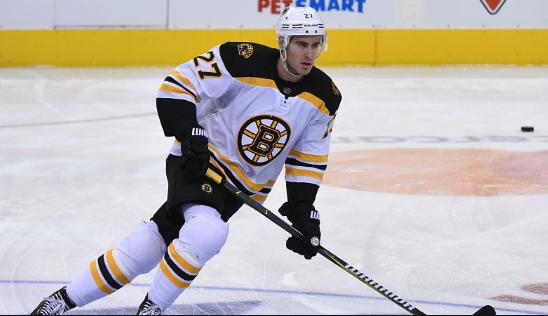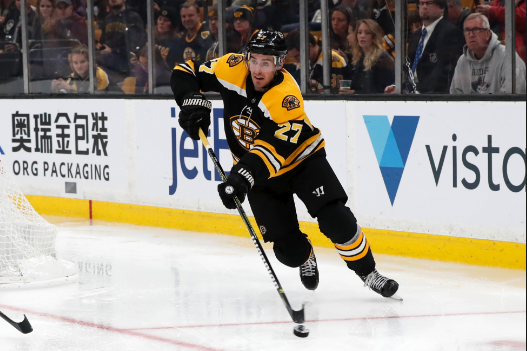
( Photo Credit: Dan Hamilton/ USA TODAY Sports )
By: Cam McCusker | Follow Me On Twitter @CSthinks
What might reasonably be forgotten or overlooked amidst the dominance with which the Boston Bruins have been playing as of late, is now riddled with injuries there roster was for a significant portion of the season. While the forward units have had battles of their own, this season has seen the ensemble of Bruins defensemen take more punishment than any other unit. Injuries to the majority of the Bruins top-7 defenseman have brought prospects like Connor Clifton, Jeremy Lauzon, and Urho Vaakanainen into the lineup for stints of their own. Steven Kampfer similarly played in more games (25) than many Bruins fans might have anticipated coming into the season.
The Bruins are not unique because of their struggles with injuries. In an 82-game season, you would be a fool to expect to throw out the same lineups every night for the duration of the season. Injuries happen to every team, almost always hurt. And, depending on where and how severely they strike, they can hurt A LOT.

( Photo Credit: Icon Sportswire/ Getty Images )
Big Credit to Me
First, let me state that I am amazingly refraining from using every corny Moore/more pun that comes into my head. Which is incredibly difficult for me, especially given that I am speaking to how an increased role (more responsibility) on Moore’s behalf alleviates a lot of the issues that the Bruins dealt with late in last season. This restraint from overusing the cheap relationship between “Moore” and “more” (woah, they sound the same but are spelled differently!) is incredibly impressive of me, many will say. But I don’t expect your praise. Just listen to my words.
Understated
John Moore’s signing in the offseason flew under the radar for most casual hockey fans. Sure, he’d been in the league a few years and is widely regarded as a “solid” defenseman—a proven entity who will neither make nor break your team’s success. His contract doesn’t break the bank, and you’d be hard-pressed to find a hockey-porn highlight video of coast-to-coast goals featuring Moore, so it registered as slightly less than newsworthy. But in the short (hopefully) examination of Moore’s game that follows, I’m hoping you can view his role like I do (Moore clearly, sorry), to understand just how big of a piece he is to the Black and Gold.
Wheels
John Moore does not play a complex style of hockey. To the lei-person, you might describe it as a “meat and potatoes” type of game. He keeps it simple, plays primarily North-South, and makes a good first pass. “Meat and potatoes” might be accurate, if you’re talking about meat and potatoes that can skate like the wind. John Moore’s biggest asset is his skating ability, something that is often overlooked due to his generally stay-at-home-iness.” I might Trademark that term, I’m not sure yet. It’s neither here nor there.
John Moore can fly. While he doesn’t possess the offensive skill set or playmaking ability of fellow blueliner Torey Krug or *insert all-star defensemen here*, he has the motor to play with significant pace, which helps the Bruins for a few reasons. Not only do Moore’s wheels help him fit in with a D core that has evolved in terms of their skating ability as a whole, but they afford him the freedom to jump up in the play as needed. Moore’s speed and hustle to get back quickly coming back to Boston’s own end allow him to play more creatively in the offensive zone, which has manifested itself through Moore making confident pinches and extending offensive zone time for the B’s.
He won’t rank among the Bruin’s most reliable puck movers, scorers, or tough guys. But John Moore plays with pace, grit, and speed. In today’s NHL and its massive emergence of speed and skill among forwards, it’s crucial to have as many defensive pieces as possible to match speed and eliminate it as a threat. I look at John Moore as a workingman’s Nick Leddy.
Depth/Health
Coming into the season, Moore was brought in to be an effective third-paring defenseman. His contract reflected the belief that the organization had in Moore to play solid minutes every night as a regular. As the season has progressed, Moore has, as of late, been looked to as the 7th defenseman. On nights where the D-core has been healthy, Moore has found himself out of the lineup. Fortunately for the Bruins, this is not a reflection of poor play on Moore’s behalf. In all honesty, this has come about due to the astounding development in the game of Matt Grzelcyk, who has not only played himself into the Bruins’ regular defensive unit but has earned himself some time on the second powerplay unit as well.
Having addressed that Moore’s status is not the result of any type of poor play, this presents itself as a great problem to have. A problem of too many good and healthy players is one that Don Sweeney and Bruce Cassidy would have killed to have last season, as their depleted defensive unit couldn’t stave off Tampa Bay’s offensive onslaught in the second round of the playoffs. When looking at Moore’s roughly $2.75M/year contract, I think most would agree the defensive depth and reliability is a resource that has proven to easily be worth $3 million, especially after seeing what Brandon Carlo’s absence did to the B’s playoff hopes.
Interestingly, as I mentioned earlier, almost all of the Bruins regular 7 defensemen have missed time this year due to injury. Among the least affected by the injury bug has been Moore himself. This has allowed the Cassidy’s Bruins to continue to field a bona fide 6-man defensive unit even when injuries have struck. Even now, the B’s find themselves down Kevan Miller for the foreseeable week or so—something that would be exponentially more troublesome if not for Moore’s steady hand and readiness on the back end. The best ability is availability, and Moore has it in spades.
Eating Minutes/Shots
In a category that is much less based in nuance, Moore’s average ice time is in the 19-minute range. By all accounts, this stat is completely unremarkable on its own. However, when it is factored into the equation (not an actual equation) that involves how much rest it provides top dogs like Charlie McAvoy, Torey Krug, and Zdeno Chara, it proves to be much more significant. Teams struggle when third-paring defenseman can only be counted on to play 12 solid minutes a night because it means that top-pairing defensemen will end up shouldering the load for at least 25 minutes. This type of even distribution that Moore can bring to the Bruins’ defense makes the unit more effective as a whole and counterbalances the negatives that fatigue can bring to many a D-core.
John Moore eats important minutes. Let’s call them his lunch. But what’s for dinner? Shots. John Moore soaks pucks. Despite having a set of tools that doesn’t extend much past his skating ability, John Moore is second among Bruins’ defensemen in blocked shots, with 72. For someone that skates as gracefully as Moore does, it’s encouraging to see him embrace the gritty side of things, which is something that Bruins fans love (see: Gregory Campbell). Moore’s willingness to put his body in harm’s way to prevent scoring chances, and doing so effectively, make him a staple on the Bruins’ penalty kill.
The Bruins’ currently hold one of the better penalty kills in the league and will need to continue to do so to get through offensive juggernauts in the East like Tampa and Toronto.
John Moore feeds the puck to Chris Wagner, who buries his fourth goal of the season and still finds time to knock Brett Seney into the net.
2-1 game. pic.twitter.com/a7trwpW2fr
— Conor Ryan (@ConorRyan_93) December 28, 2018
https://platform.twitter.com/widgets.js
For those who wished to skip the details of what John Moore means to this Bruins team, the three-word summary reads as follows: He is important.
Moore brings speed, depth, health, grit, and perhaps most importantly, he brings experience to a team that has its fair share of talented yet inexperienced players. All evidence points to John Moore’s continued unheralded contributions to a successful Bruins team. He won’t get recognized for it by most people.
But I don’t think he’ll care.


Leave a Reply